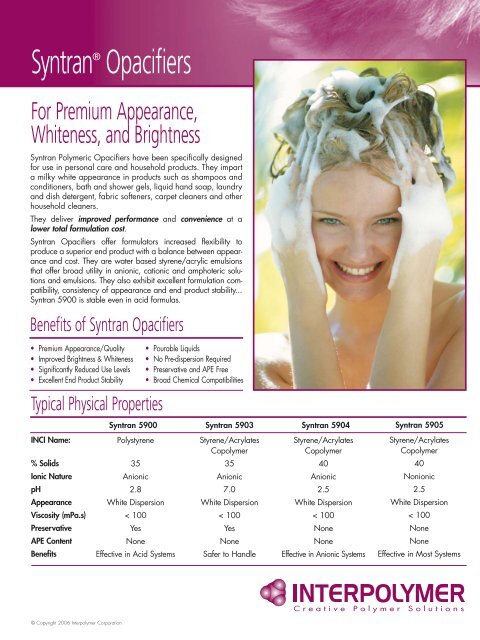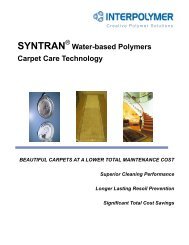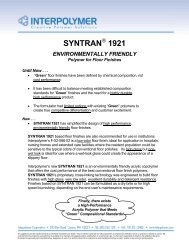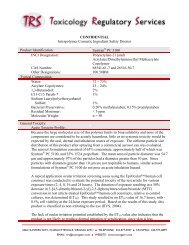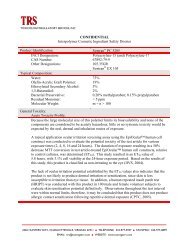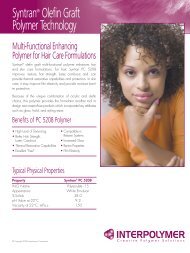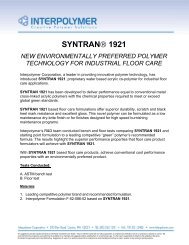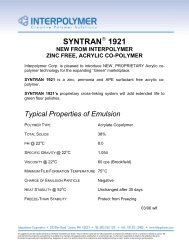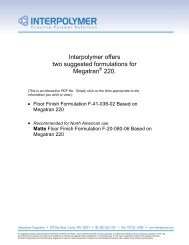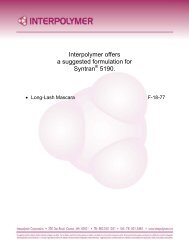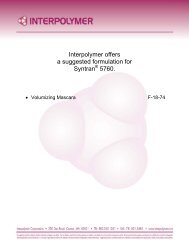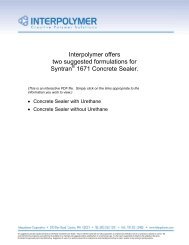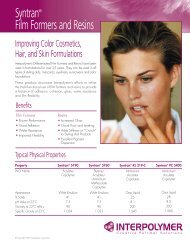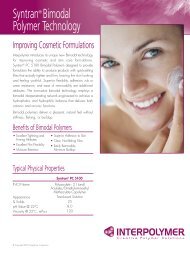Syntran Opacifiers
06-531 Opacifier Data Sheet - Interpolymer
06-531 Opacifier Data Sheet - Interpolymer
You also want an ePaper? Increase the reach of your titles
YUMPU automatically turns print PDFs into web optimized ePapers that Google loves.
<strong>Syntran</strong> ® <strong>Opacifiers</strong><br />
For Premium Appearance,<br />
Whiteness, and Brightness<br />
<strong>Syntran</strong> Polymeric <strong>Opacifiers</strong> have been specifically designed<br />
for use in personal care and household products. They impart<br />
a milky white appearance in products such as shampoos and<br />
conditioners, bath and shower gels, liquid hand soap, laundry<br />
and dish detergent, fabric softeners, carpet cleaners and other<br />
household cleaners.<br />
They deliver improved performance and convenience at a<br />
lower total formulation cost.<br />
<strong>Syntran</strong> <strong>Opacifiers</strong> offer formulators increased flexibility to<br />
produce a superior end product with a balance between appearance<br />
and cost. They are water based styrene/acrylic emulsions<br />
that offer broad utility in anionic, cationic and amphoteric solutions<br />
and emulsions. They also exhibit excellent formulation compatibility,<br />
consistency of appearance and end product stability...<br />
<strong>Syntran</strong> 5900 is stable even in acid formulas.<br />
Benefits of <strong>Syntran</strong> <strong>Opacifiers</strong><br />
• Premium Appearance/Quality<br />
• Improved Brightness & Whiteness<br />
• Significantly Reduced Use Levels<br />
• Excellent End Product Stability<br />
Typical Physical Properties<br />
INCI Name:<br />
% Solids<br />
Ionic Nature<br />
pH<br />
Appearance<br />
Viscosity (mPa.s)<br />
Preservative<br />
APE Content<br />
Benefits<br />
<strong>Syntran</strong> 5900 <strong>Syntran</strong> 5903 <strong>Syntran</strong> 5904<br />
Polystyrene<br />
35<br />
Anionic<br />
2.8<br />
White Dispersion<br />
< 100<br />
Yes<br />
None<br />
Effective in Acid Systems<br />
• Pourable Liquids<br />
• No Pre-dispersion Required<br />
• Preservative and APE Free<br />
• Broad Chemical Compatibilities<br />
Styrene/Acrylates<br />
Copolymer<br />
35<br />
Anionic<br />
7.0<br />
White Dispersion<br />
< 100<br />
Yes<br />
None<br />
Safer to Handle<br />
Styrene/Acrylates<br />
Copolymer<br />
40<br />
Anionic<br />
2.5<br />
White Dispersion<br />
< 100<br />
None<br />
None<br />
Effective in Anionic Systems<br />
<strong>Syntran</strong> 5905<br />
Styrene/Acrylates<br />
Copolymer<br />
40<br />
Nonionic<br />
2.5<br />
White Dispersion<br />
< 100<br />
None<br />
None<br />
Effective in Most Systems<br />
© Copyright 2006 Interpolymer Corporation
<strong>Syntran</strong> <strong>Opacifiers</strong><br />
1106<br />
Selection Criteria – <strong>Syntran</strong> <strong>Opacifiers</strong><br />
Personal Care Opacifier Selector Guide<br />
Household and I & I Opacifier Selector Guide<br />
Application<br />
5903<br />
5904<br />
5905<br />
Application<br />
5900<br />
5904<br />
5905<br />
Bath and Shower Products<br />
Shampoos<br />
Liquid Hand Soaps<br />
Hair Conditioners<br />
Cationic Systems<br />
Skin Lotions<br />
Nonionic Systems<br />
✔<br />
✔<br />
✔<br />
✔<br />
✔<br />
✔<br />
✔<br />
✔<br />
✔<br />
✔<br />
✔<br />
✔<br />
✔<br />
✔<br />
Industrial Strength Hand Soaps<br />
Liquid Dish Detergents<br />
General Cleaners<br />
Carpet Cleaners<br />
Fabric Softeners<br />
Laundry Detergents<br />
Toilet Bowl Cleaners<br />
✔<br />
✔<br />
✔<br />
✔<br />
✔<br />
✔<br />
✔<br />
✔<br />
✔<br />
✔<br />
✔<br />
✔<br />
✔<br />
Transmittance at 530 nm<br />
50<br />
40<br />
30<br />
20<br />
10<br />
0<br />
25.6<br />
<strong>Syntran</strong> 5903<br />
Anionic Control Formula<br />
Transmittance of Opacifier<br />
25.0<br />
<strong>Syntran</strong> 5904<br />
43.6<br />
Competitive<br />
Brand<br />
min<br />
Opacity<br />
max<br />
Addition of Opacifier at 0.02%<br />
(Use level tested was 0.2% diluted to 0.02% for graphical comparison)<br />
Transmittance at 530 nm<br />
50<br />
40<br />
30<br />
20<br />
10<br />
0<br />
Cationic Control Formula<br />
Transmittance of Opacifier<br />
24.8<br />
<strong>Syntran</strong> 5905<br />
40.6<br />
Competitive<br />
Brand<br />
min<br />
Opacity<br />
max<br />
Addition of Opacifier at 0.02%<br />
(Use level tested was 0.2% diluted to 0.02% for graphical comparison)<br />
Salt Tolerance: <strong>Syntran</strong> <strong>Opacifiers</strong> are very tolerant of high<br />
electrolyte concentrations. All four are compatible with NaCl<br />
concentrations greater than 8%. <strong>Syntran</strong> 5903 shows the best<br />
tolerance for these monovalent ions.<br />
Formulating with <strong>Syntran</strong> <strong>Opacifiers</strong><br />
<strong>Syntran</strong> <strong>Opacifiers</strong> should preferably be added at the end of the<br />
manufacturing cycle (i.e. after final adjustment).<br />
To prevent potential “shock”, <strong>Syntran</strong> opacifiers can be pre-diluted<br />
with soft or deionized water at a range of 1 part to 3 - 4 parts<br />
water prior to use. The addition of opacifier to the base product<br />
needs to be made very slowly under good agitation.<br />
Only a small amount of opacifier is required to opacify most<br />
products and to achieve the desired effect in formulation. As little<br />
as 0.1% up to 1% is all that is needed.<br />
<strong>Opacifiers</strong> Testing<br />
<strong>Opacifiers</strong> should always be checked for stability on all opacified<br />
products. To define the stability of a product, 4 tests are performed:<br />
– at room temperature<br />
– at 40˚C<br />
– at 5˚C<br />
– 3 freeze/thaw cycles<br />
Stability should be observed over the desired period of time.<br />
Transmittance measurements show <strong>Syntran</strong> <strong>Opacifiers</strong> to be<br />
more effective than commercial opacifiers used for reference.<br />
Measurement was calculated using a UV-visible spectrophotometer<br />
at a wavelength of 530 nm.<br />
Interpolymer<br />
Corporation<br />
200 Dan Road<br />
Canton, MA 02021<br />
TEL: 800.262.1281<br />
FAX: 781.821.2485<br />
www.interpolymer.com<br />
info@interpolymer.com<br />
Interpolymer<br />
Sàrl<br />
6, Rue Marie Curie<br />
F-67162 Wissembourg, France<br />
TEL: [+33] 3/88 54 96 96<br />
FAX: [+33] 3/88 54 96 99<br />
www.interpolymer.fr<br />
info@interpolymer.fr<br />
Interpolymer<br />
Corporation<br />
7501 Distribution Drive<br />
Louisville, KY 40258<br />
TEL: 800.451.8177<br />
FAX: 502.933.3394<br />
www.interpolymer.com<br />
info@interpolymer.com<br />
Interpolymer<br />
GmbH<br />
Dr.-Wirth-Strasse 9a<br />
67454 Hassloch, Germany<br />
TEL: +49 6324 593106<br />
FAX: +49 6324 593107<br />
www.interpolymer.de<br />
info@interpolymer.de


